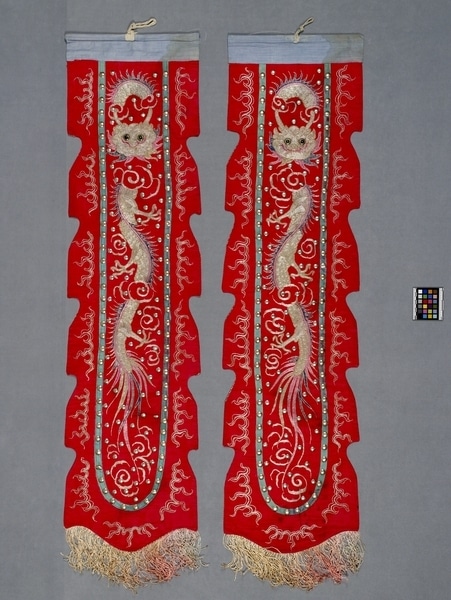Cantonese Opera Banner Item Number: N1.738 a-b from the MOA: University of British Columbia


Description
Complementary panels, with dragon and flame motifs. Gold, silver, blue, and turquoise on red ground. Blue cotton border (2 3/4"deep) at top of hanging, doubled over bamboo piece for suspension. String loop attached at centre top. Yellow shading to pink fringe at bottom. Cotton calico lining, small white circles on red ground. Hanging panels pair.
History Of Use
These banners would have been held on poles in pairs by standing attendants. They may have indicated the presence of an emperor or empress.
Costumes, stage fittings, and props from the period before World War II can be dated in part by their ornamentation. Those decorated with silver-coated brass disks are likely to be the oldest, followed by those decorated with mirrors. Sequins came into use in the 1930s, although they had been used sparingly before, and heavily-sequined costumes came into use in the late 1930s, continuing into the 1950s.
The conditions of production of costumes pre World War II are not known with certainty. As most costumes have repeated motifs, some method must have been used to replicate them for embroidery and couching. This work was probably done on a putting-out basis under the auspices of the production company, by women. The final finishing may have been done by men in the company headquarters.
Iconographic Meaning
Dragons normally represent the imperial presence.
Cultural Context
theatre
Specific Techniques
Wear on this and other costume elements shows that the fabric was woven with a silk weft and cotton warp, or vice versa. Seams are enclosed. Visible stitching was done by machine.
Narrative
A large group of Cantonese opera costumes, musical instruments, props, trunks, and stage fittings was left with the Jin Wah Sing Musical Association, apparently by some of the many itinerant troupes visiting Vancouver to perform in the Chinatown theatres in the pre World War II period. There is no certain knowledge of why these materials were not taken back to China by them. They were used by the Jin Wah Sing Musical Association in their performances until they became too dated. The association continued to preserve them carefully, storing them in their headquarters and in the basement of the Chinese Freemasons building until several groups of materials were sold and donated to the Museum of Anthropology.
Item History
- Made in Guangzhou, Guangdong, China ? during 1920
- Collected in Vancouver, British Columbia, Canada
- Owned by Jin Wah Sing Musical Association before August 28, 1973
- Received from Barrett Montford Endowment Fund (Funding source), Jin Wah Sing Musical Association (Seller), Leon & Thea Koerner Foundation (Funding source), Museum of Anthropology Donations Fund (Funding source), Mah Society of North America (Funding source), Canada-China Friendship Association (Funding source), Quon H. Wong Agencies (Funding source) and Edith Low-Beer (Funding source) on August 28, 1973
What
- Name
- Cantonese Opera Banner
- Identification Number
- N1.738 a-b
- Type of Item
- banner
- Material
- silk fibre, cotton fibre, dye, silver metal, bamboo grass, brass metal and glass
- Manufacturing Technique
- spun, woven, dyed, cut, couched and twisted
- Part A
- height 35.5 cm, width 132.5 cm
- Part B
- height 35.0 cm, width 135.8 cm
Who
- Culture
- Chinese: Cantonese
- Previous Owner
- Jin Wah Sing Musical Association
- Received from
- Barrett Montford Endowment Fund (Funding source), Jin Wah Sing Musical Association (Seller), Leon & Thea Koerner Foundation (Funding source), Museum of Anthropology Donations Fund (Funding source), Mah Society of North America (Funding source), Canada-China Friendship Association (Funding source), Quon H. Wong Agencies (Funding source) and Edith Low-Beer (Funding source)
Where
- Holding Institution
- MOA: University of British Columbia
- Made in
- Guangzhou, Guangdong, China ?
- Collected in
- Vancouver, British Columbia, Canada
When
- Creation Date
- during 1920
- Ownership Date
- before August 28, 1973
- Acquisition Date
- on August 28, 1973
Other
- Item Classes
- textiles
- Condition
- good
- Accession Number
- 0248/0123